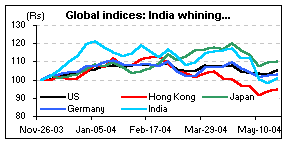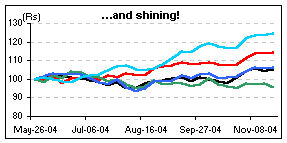The past twelve months have brought about a host of challenges for the global economy to maintain the string growth momentum that was witnessed in the preceding period (before November 2003). Everything -- crude prices, inflation and interest rates -- seemed to be rising.
In India's case, apart from these factors, there was one more challenge - change of power at the Centre. And when the incumbent government was replaced (quite unexpectedly) by a Left-supported coalition, the doomsayers emerged from their shells to spell a tough future for the country!
As a result, the markets reacted sharply (remember May 17, 2004?)
 |
 |
In the backdrop, the crude prices continued to move up. While it is a subjective matter whether the rise has been demand-led or supply-led, the fact of the mater is that global economic growth has been impacted, though not severely.
This rise in crude prices has then fueled high inflation that has consequently led to the global central banks resorting to raising interest rates. The increase in interest rates in some key economy was also to soften growth in retail credit.
The Indian economy has also felt the reverberations of this rise in global crude prices, inflation and interest rates.
However, what we are witnessing now is the cooling off of inflation (measured by the wholesale price index, the WPI) in the economy, but still remaining at higher levels than seen in the past two years. The central bank has also indicated a rise in interest rates, this being a result of both high inflation and high credit offtake from both the retail and the corporate segments.
Now, despite these pressures on the interest rate front, Indian equities have outperformed the global peers during the past six months (see graph above).
The fact that the current UPA government seems to be reform-oriented (despite having support of the Left!) has given a fillip to the Indian markets that have also benefited from continued inflow of FII money.
For instance, in the year 2004-till date, almost Rs 301 bn ($6.6 billion) of FII money has flowed into Indian equity markets. And this has provided the bulls one more reason to believe that the Indian growth story has a long way to go.
As the markets hover around the 6,000 levels, it is time for retail investors to gauge their risk-return profile well as at these 'high' times, there are enough noises being made that the markets are going to cross much higher levels in the short-term period. Tread with caution!
Equitymaster.com is one of India's premier finance portals. The web site offers a user-friendly portfolio tracker, a weekly buy/sell recommendation service and research reports on India's top companies.








More from rediff